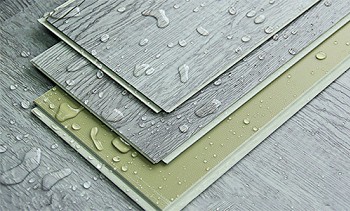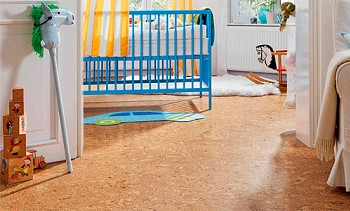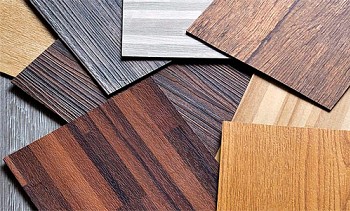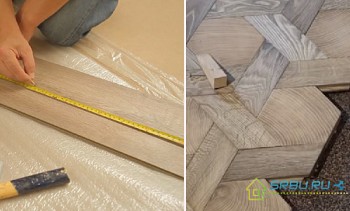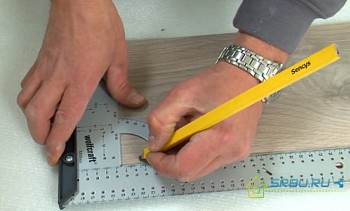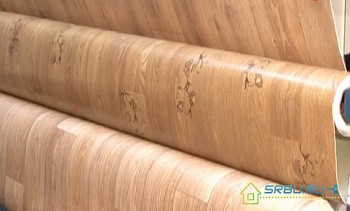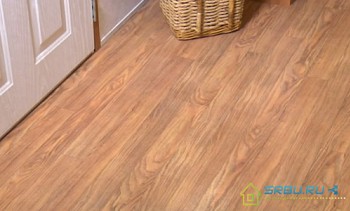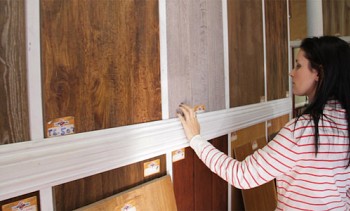It would seem that it is not difficult to pick up a parquet board. It is enough to love the material and the pattern, and the thing is in the hat. But no - it turns out that you need at least a little, but to understand the properties of the tree. After all, different companies produce very similar in appearance parquet boards, the characteristics of which can vary significantly. So, a parquet board how to choose it correctly, which manufacturer to prefer, what to pay attention to, first things first.
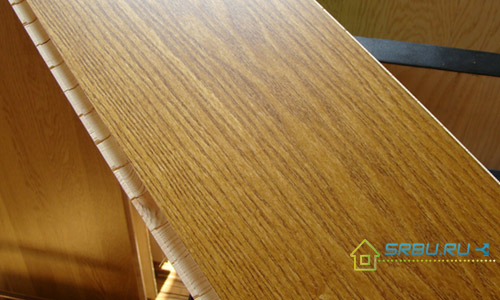
Content:
- What and how to make a parquet board
- The variety of parquet boards their types and selection
- How to choose parquet so that it pleases the eye and lasts a long time
- Features to consider when choosing the color of the floorboard
- What you need to pay attention to when choosing a parquet board
- The quality indicators of the floorboard, which you will not see but need to know about them
- Table of the main characteristics of valuable wood species
- Video: Parquet board - selection and styling
What and how to make a parquet board
This flooring is multi-layer. The outer layer is a very effective wood of valuable species. Its a little - it's just a veneer plate. To prevent a beautiful tree from being washed, it is covered with varnish or special parquet oil on top.
So that the floor does not deform when the temperature and humidity conditions change, the inner layer of the parquet board is made of HDF boards (rarely), or from boards (lamellas) made of inexpensive wood. Moreover, this layer, which includes locks, is perpendicular to the finish veneer. To prevent the parquet from bending and gaining the necessary rigidity, one more layer is added - the wrong layer.

Well, now we will consider what stages the process of manufacturing parquet consists of.
- First of all, you need to select the right-sized boards from the tree of valuable species. They should not be defective. The selected material should be well dried, and then cut into pieces of the desired length and width. The resulting identical boards are ground and sorted, checking compliance with the given parameters.
- Proceed to the manufacture of the lower and central layers of the floorboard. They use cheaper wood. Take edged boards, sawing them into lamellas of the right size. Veneer plates are also made from them. Next, the material should be dried.
- It remains only to collect all this "layer cake". First, the finishing is glued to the middle layer. As already mentioned, the lamellas are perpendicular to the decorative veneer. After the glue has dried, the base is glued to the central layer.
- The last stage is the cutting of the castle joints in the inner part of each parquet. For this, a milling machine is used.
If the inside of the parquet board is not made of wood, but of HDF, then there are no special differences in the technology of its manufacture. First, a veneer made of valuable wood is glued to a dense HDF panel, and then a base that does not allow the parquet to bend.
The variety of parquet boards their types and selection
When deciding which floorboard to choose, it will be nice to know what its varieties are. We list them.

Parquet board single-lane - its finishing layer is a solid canvas. The pattern of wood appears most beautifully and clearly.

Two-way parquet board - the top layer consists of two lamellas, carefully fitted. By length, they can be divided into 2 or 3 parts.

Three-lane parquet board - 3 rows of slats in it are located in parallel. They are offset in length, and the result is a characteristic pattern - deck, wicker or Christmas tree,

Four-lane parquet board - is made according to the same principle, only lamellas in the upper layer are already 4.
Multilayer parquet board - its upper layer is a multicolor pattern of small planks. Very decorative.
Selection of a parquet board is a sorting of its upper layer according to such indicators as:
- Sawing method;
- the number of knots on wood, their size;
- at what angle are the wood fibers;
- is there a sapwood, and if so, its size;
- surface color.
Each manufacturer has its own selection requirements. However, there are a sufficient number of general sorting options. In particular, the method by which the wood is sawn for the upper finishing layer.
Cutting methods
There are two ways to cut - radial and tangential.
1. Radial cut - this is cutting the trunk of a tree along a line through its core. With this method, the board along the entire length has a uniform texture and color. Its fibers are parallel to the annual rings of the tree, as a result, the distance between these rings is very small. With the radial method, the wood dries and swells half as much as with the tangential one. But at the same time it turns out a lot of waste and marriage, and the board as a result comes out not cheap.
2. Tangential type cut characterized by the fact that the cut lines do not pass through the center of the trunk and touch the tree rings. As a result, the surface of the board has a bright and interesting pattern, on which these rings clearly appear. The price of such a board is lower, since it is rejected quite a bit. But its technical characteristics are inferior to the radial board.
3. Mixed cut - This is a method in which both radial and tangential cuts are combined.

Classification of the top layer of parquet board
1. Radial Select.
It is considered the highest grade of parquet. Its texture is uniform, absolutely no heart-shaped rays are observed. Wood does not contain a single knot and defect. Sapwood is also not observed. According to GOST 862.1-85, such a tree corresponds to category A.
However, the surface of such parquet does not look very original, one might even say it is too simple. Its pattern is simple, there are few color shades. Therefore, such wood is rarely used for parquet boards. As a rule, shield parquet is made of it.

2. Select.
Another name for this parquet variety is standard. He also belongs to the highest category. The natural pattern is clearer, and the smooth and delicate transitions from tone to tone are deeper than with the previous cut. Wood defects such as knots and scratches are not allowed. There should not be sapwood. According to characteristics, according to GOST 862.1-85, this tree also corresponds to category A.

3. Natur.
The cut of this parquet variety is mixed. That is, there are boards in it, sawn both radially and tangentially. Despite the fact that this parquet belongs to the highest grade, small knots (not more than 2 mm) can be found in it, as well as veins, heart-shaped rays and sapwood. Drawing of a natural tree is shown very brightly, differences of shades are well visible. Each manufacturer indicates its allowable number of such defects.

4. Rustic.
In this kind of parquet, the second name of which is country, there are also boards sawn in both ways. A beautiful natural pattern is very visible, the transitions from tone to tone are very effective. As for quality, there can be sapwood, and minor damage to wood, and veins, and fibers located obliquely. Knots, even large enough, are perfectly acceptable, as are heart-shaped rays. Wood, according to GOST 862.1-85, corresponds to category B. The number of permissible defects is determined by the manufacturer.

5. Economy.
The second name of this parquet variety is robust. However, even the first name makes it clear that this is the cheapest variety. There is no strict cut rate. In this parquet there may be boards sawn in any of the ways, and in any ratio.The manufacturer himself determines how many cracks, knots, and heart-shaped rays can be in the wood. Sapwood, inclined fibers and veins are quite allowed.

How to choose parquet so that it pleases the eye and lasts a long time
Choosing a practical decor
Often when choosing a floorboard, the owners of the apartment first of all pay attention to the appearance. However, this is not always true from a practical point of view, especially if a dark board is purchased. She looks, no doubt, luxurious and elegant. But you need to take care of such a floor very carefully - it will not tolerate careless handling. It should be noted that the most “tender” and completely impractical is the dark one-color parquet with a shiny lacquered surface. If you scratch it (and it still happens sooner or later), then the ugly white stripes will be very noticeable.
Therefore, if your dream is certainly parquet of dark shades, then opt for a matte varnish. An oil coating is also suitable. Not so noticeable will be scratches on the floor, the surface of which has a two-tone contrasting pattern. It can be either a brushed board of two colors, or an exotic dark wood without the effect of tinting. After all, if the flooring has differences in color tones, then minor damage and dust are not so evident.
Lacquered or oil coated?
There is no strict rule in this case. But it is more practical to lacquer a light parquet board, and a dark one - to coat with an oil mixture or wax.
Heat treatment
Heat treatment - a process in which the wood is heated to about 185 0C, this gives the floorboard greater stability and provides deep staining. In the future, scratches may not be so visible on such a board. However, some wood species treated in this way in the future may fade under the influence of light, which exactly look in the table at the bottom of this material.
About brushing
This treatment is mainly subjected to oak flooring. When brushing on the outer layer of the board are special brushes. As a result, soft wood fibers are removed, and the surface acquires a relief. Thanks to this, scratches or dents that appeared on the floor are perfectly masked. Caring for it is not difficult, accumulation of dirt in small relief depressions is not formed.

Barefoot on this floor is nice to walk - it is warm to the touch, a splinter from the tree does not happen.
Three stripes or one?
Often you have to decide which parquet board is better to choose - single-lane or three-lane. The choice depends on how much free space is available in the room. Naturally, you need to consider that part of the room will be occupied by furniture - we do not take this area into account. Thus, if the free space of the floor is small, it is better to stay on a three-lane parquet board.
If you still want to choose a single-lane parquet of the highest grade for a small room, then purchase small boards. For example, from manufacturers Coswick, Barlinek or Panaget. It should be noted that a single-lane parquet board is not as prone to deformation as a three-lane one. After all, even if its middle layer changes its dimensions under adverse conditions, the upper solid canvas will not allow the board to deform.
Type and generation of lock system
It is not so important what generation the castle is on the parquet board. The advantage of modern 5G-locks with plastic inserts is only the speed of assembly. But it can not be a determining factor that the floor is going in a couple of hours instead of four. But specialists in parquet laying evaluate their work based on what type of castle is assembled.
Parquet board compatibility with warm floors
Regarding compatibility with warm floors, we can say that there is no parquet board ideally suited for them.All manufacturers of wooden flooring say one thing: what can not be combined with heated floor wood species that absorb moisture well. In particular, this is maple, beech, jatoba (Brazilian cherry) and several other exotic species.
Dependence of the quality of the board on the hardness of the top layer of wood
The quality of a parquet board is almost independent of the hardness of the wood from which it is made. After all, if you walk on the floor on sharp "stilettos", then traces will remain in any case. By the way, mahogany and other exotic species with high density can be used only in those rooms where the temperature and humidity are quite stable.
Features to consider when choosing the color of the floorboard
Neither on the Internet, nor in the catalog can you find out exactly what color a parquet board has. After all, she was photographed by different cameras, as well as under different lighting conditions. In addition, the computer monitor may distort colors. Therefore, only a trip to the store will help you choose the right shade.
It is best to choose parquet during daylight hours so that cold light from fluorescent lamps does not distort the picture. After all, at home, we usually use lamps with warm light, reminiscent of natural sunlight.
And one more tip on how to choose the right floorboard in the store. It is necessary to lay her on the floor so that the light from the window falls on her in the same way as in the apartment.
A large-format board is not selected by any manufacturer for cutting. Therefore, in a parquet made of the same wood, there will be a natural texture. So do not try to look for a particularly beautiful pattern of oak flooring, sorting through the products of different companies.
As for the varieties of the floorboard, they may differ from different manufacturers. Basically, the Natur variety is used, in which there are a number of defects. This wood with large knots is used for dark shades of parquet that will be tinted. Light parquet is made from higher quality raw materials because there the knots will be too conspicuous.
When choosing a parquet board, keep in mind that in one batch the shades of wood may vary slightly. After all, even boards made from the same tree trunk still have slight color differences. Especially noticeable is the difference in shades of mahogany. An operation such as toning smooths out color differences. But even after it, the shades will be slightly different. By the way, tinting of two different lots of parquet can also give different results.

Non-tinted wood will blend well with furniture, baseboards and door frames. In addition, it is easier to restore it than a tinted tree.
What to look for when buying a floorboard
The display window usually either has individual slats or panels are assembled from them. The bar is good in that it allows you to consider the material from all sides, evaluating its technical characteristics. And on the shield you can see the joint and how the shades of the individual slats are combined with each other. Just remember that shields are usually selected - low quality or unsightly trims simply are cut off or not taken to create a shield.
Therefore, when deciding how to choose a floorboard manufacturer, look at different models. That is how you objectively evaluate the quality of the products of this company. After all, the technological line for all models is the same - flaws, if any, will manifest themselves sooner or later.
It is important that the wood of which the parquet is made is properly dried. This process cannot be called fast. Therefore, a cheap parquet board is often half-finished - its manufacturers are too in a hurry to make a profit. The specialist will be able to determine how dry the board is by the sound (characteristic crunch).Well, and if there is no such experience, is it possible to determine that the parquet is made of raw wood? There are several tricks - we list them.
- At a three-strip board, the lamellas should not protrude - its surface should be even and smooth. However, an exception is made for wood species that absorb moisture well. This, for example, jatoba, birch, cherry, maple, beech. All manufacturers allow slight differences in height of the lamellas. But for oak (or other stable wood), this is already a marriage.
- A three-strip board should have inconspicuous and beautiful joints between the lamellas. An indicator of the high quality of the brand is the presence of a single-lane parquet, which does not have a chamfer.
- There should not be chipped varnish coating at the joints between the lamellas. This means that the board was raw. This is especially evident on the dark wood flooring.
- If there are incomprehensible light stripes on a dark parquet, this means that the varnish was applied to the wood immediately, without priming the surface. Such a lacquer coating will inevitably crack when the wood narrows and expands.
- Take a look at the inner layer of the parquet board. Ideally, it should be made of identical bars sawn by the radial method. There should be some space between them to prevent the possible expansion of wood in the summer. Moreover, a small number of knots dropped out is quite allowed, since this does not affect the strength of the parquet.
- It is impossible that the gap between the blocks of the inner layer and the joint of the upper lamellas coincide. But for a cheap flooring this is almost the norm, unfortunately. During the change of seasons, this leads to cracking of varnish at the joints. Therefore, for a parquet board with an average and high price, such a defect is unacceptable.
- The veneer layer on the underside of the board must be solid. Material - birch or pine. It does not matter if there are traces of small or medium knots that have fallen out. Chinese parquet is different in that it is made from hevea wood from the inside out - this is not practiced in Europe. Such a veneer has no knots, and its surface is slightly fleecy.
- The cheapest types of flooring have the wrong side, assembled from separate parts. Usually plywood waste is used for this. The board becomes less stable because of this, but it cannot be said that it is much worse than other budget options. After all, price reduction inevitably entails the appearance of shortcomings.
- The thickness of the finish layer matters. Even if the manufacturer swears that this layer is 4 mm (this is the norm), it is better to check visually. Indeed, it may actually turn out that its thickness is only 3, or even 2.5 mm. Although this does not affect the stability of the floorboard, cheating is a hoax - you can no longer trust such a manufacturer.
- Arriving at the store, smell the parquet. There should not be extraneous odors, except for the faint smell of a tree. If you feel "chemistry", then there is a reason to beware. This means that paints were used, which, when evaporated, can cause harm to health, especially to children. But the slight smell of burnt wood should not cause suspicion. However, this only applies to dark parquet, which has undergone heat treatment. After a while, there will be no smell or trace left.
- If the parquet board is slightly curved, then this is not a marriage. The fact is that the straps, when pulled out of the film packaging, absorb a certain amount of moisture from the air. Even a premium board can bend. Although, ideally, wood that dries for a long time under natural conditions is practically unaffected by changes.
The quality indicators of the floorboard, which you will not see but need to know about them
1. A tree that has dried over a long period under natural conditions does not change its properties and dimensions under fluctuations in temperature and humidity. At the joints between the lamellas, such a board will not show cracks in the varnish or cracks. Even if the floor is completely flooded with water, then a parquet board of the correct drying will not spoil.
2. A lot of glue is required to connect the layers of the floorboard.Conscientious manufacturers take eco-friendly PVA glue for this. The board is durable and lasts a long time. BUT this is quite expensive. Therefore, not very honest manufacturers, trying to save money, reduce the amount of glue or take cheap glue of low quality. Not only can it be harmful to humans, but also parquet begins to creak and delaminate. In particular, its top layer moves away from the board.
3. The environmental friendliness and appearance of the parquet also depends on how varnish and oil it is coated. Too cheap varnish is quickly scratched. And more: it is not so important how many layers of varnish are available. Main quality. Obviously, 2 layers of good varnish is better than 10 layers of cheap varnish.
So that you can navigate the characteristics of valuable wood species, we present to you the following table, which will help determine the choice of this flooring.
Table of the main characteristics of valuable wood species
| Wood species | Hardness, Brinell average | Stability in Conventional Units | The ability to change color over time in the world |
|---|---|---|---|
| Oak, Red Oak | 3,7 | 4 | Does not change |
| Beech | 3,8 | 1 | Gets a reddish tone |
| Beech + heat treatment | 4,1 | 2 | In the light fades over time |
| American Cherry | 3,2 | 4 | It is getting very dark |
| European Cherry and Sweet Cherry | 3,5 | 4 | It is getting very dark |
| Maple Canadian | 4,8 | 2 | Gets a creamy tint |
| European maple | 4,0 | 2 | Acquires a yellowish tone |
| American Walnut | 4,0 | 4 | Changes the color to a tobacco brown |
| Walnut European / Greek | 5,0 | 4 | The tone of the wood can be up to light brown. |
| Ash | 4,0 | 2 | The tone of the wood can be from white to grayish pink. |
| Ash + heat treatment | 4,3 | 3 | In the light, fades over time |
| Birch tree | 3,0 | 3 | Wood may contain many darker knots |
| Birch + Heat Treatment | 3,2 | 4 | In the light, fades over time |
| Birch Korelskaya / Scandinavian | 3,5 | 3 | Does not change |
| Pear | 3,5 | 2 | In the light, over time acquires a green reddish tone |
| Acacia | 4,0 | 2 | The tone of the wood can be from white-yellow to white-pink, which does not change |
| Exotic Wood | |||
| Amaranth | 5,0 | 3 | It gets very dark |
| Angelica | 4,4 | 2 | It gets very dark |
| Aphormosia | 3,8 | 3 | It gets very dark |
| Bubinga | 4,2 | 3 | It is getting very dark |
| Wenge | 4,2 | 2 | Darkens to charcoal black |
| Race / Tiger Tree | 4,1 | 2 | The wood has a double color and with a vermen, it darkens in the light |
| Dussi / Afzelia | 4,0 | 4 | It is getting very dark |
| Zebrano | 3,2 | 3 | Wood has a double color and darkens with time. |
| Iroko / Flounder | 3,5 | 5 | It is getting very dark |
| Ipe / Lapacho | 6,0 | 2 | It is getting very dark |
| Kepas | 5,5 | 1 | It is getting very dark |
| Kurupai | 5,0 | 4 | The wood has a clear double color, with time it darkens slightly in the light |
| Macassar | 5,5 | 2 | The wood has a double color and darkens with time, in the light |
| Mahogany / Sapele | 4,2 | 3 | It is getting very dark |
| Mengaris | 5,0 | 3 | It is getting very dark |
| Merbau | 4,5 | 4 | It is getting very dark |
| Moabi | 4,1 | 3 | It is getting very dark |
| Muteniya / Arieskol | 4,4 | 3 | Darkens noticeably |
| Nogal | 3,5 | 3 | Visibly brightens and fades |
| Olive / Olive Tree | 6,0 | 3 | Drervesina has a double color and darkens over time |
| Rosewood | 3,5 | 3 | Changes color to taupe |
| Panga | 3,5 | 3 | Darkens noticeably |
| Rosegum | 5,2 | 2 | It is getting very dark |
| Pink Drervo | 4,4 | 3 | Darkens noticeably |
| Sucupira | 5,0 | 2 | Darkens noticeably |
| Teak | 3,5 | 5 | Darkens noticeably |
| Yarra | 5,5 | 2 | Darkens noticeably |
| Jatoba | 5,5 | 3 | It is getting very dark |
|
Explanation of stability values:
|
|||
Video: Parquet board - selection and styling

